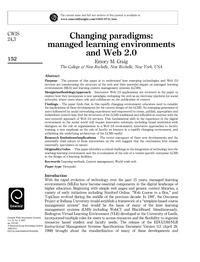Changing paradigms: managed learning environments and Web 2.0Emory M. Craig
Publikationsdatum:
|
 |
 Diese Seite wurde seit 7 Jahren inhaltlich nicht mehr aktualisiert.
Unter Umständen ist sie nicht mehr aktuell.
Diese Seite wurde seit 7 Jahren inhaltlich nicht mehr aktualisiert.
Unter Umständen ist sie nicht mehr aktuell.
 Zusammenfassungen
Zusammenfassungen
Purpose – The purpose of this paper is to understand how emerging technologies and Web 2.0 services are transforming the structure of the web and their potential impact on managed learning environments (MLS) and learning content management systems (LCMS).
Design/methodology/approach – Innovative Web 2.0 applications are reviewed in the paper to explore how they incorporate a new paradigm, reshaping the web as an electronic platform for social networks, where users share, edit and collaborate on the publication of content.
Findings – The paper finds that, in this rapidly changing environment, educators need to consider the implications of these developments for the current design of the LCMS. An emerging generation of users influenced by social networking experiences and empowered to create, publish, appropriate and redistribute content may find the structures of the LCMS traditional and inflexible in contrast with the user-centered approach of Web 2.0 services. This fundamental shift in the experience of the digital environment in the social world will require innovative solutions, including broad institution-wide dialogues on the role of organizations in a Web 2.0 environment, innovative approaches to faculty training, a new emphasis on the role of faculty as learners in a rapidly changing environment, and rethinking the underlying architecture of the LCMS model.
Research limitations/implications – The recent emergence of these new developments and the essentially fluid nature of these innovations on the web suggest that the conclusions here remain essentially speculative in nature.
Originality/value – This paper identifies a critical challenge in the integration of technology into the teaching-learning environment and the re-evaluation of the role of a vendor-specific enterprise LCMS in the design of e-learning facilities.
Von Klappentext im Text Changing paradigms: managed learning environments and Web 2.0 (2007) Design/methodology/approach – Innovative Web 2.0 applications are reviewed in the paper to explore how they incorporate a new paradigm, reshaping the web as an electronic platform for social networks, where users share, edit and collaborate on the publication of content.
Findings – The paper finds that, in this rapidly changing environment, educators need to consider the implications of these developments for the current design of the LCMS. An emerging generation of users influenced by social networking experiences and empowered to create, publish, appropriate and redistribute content may find the structures of the LCMS traditional and inflexible in contrast with the user-centered approach of Web 2.0 services. This fundamental shift in the experience of the digital environment in the social world will require innovative solutions, including broad institution-wide dialogues on the role of organizations in a Web 2.0 environment, innovative approaches to faculty training, a new emphasis on the role of faculty as learners in a rapidly changing environment, and rethinking the underlying architecture of the LCMS model.
Research limitations/implications – The recent emergence of these new developments and the essentially fluid nature of these innovations on the web suggest that the conclusions here remain essentially speculative in nature.
Originality/value – This paper identifies a critical challenge in the integration of technology into the teaching-learning environment and the re-evaluation of the role of a vendor-specific enterprise LCMS in the design of e-learning facilities.
 Dieser Text erwähnt ...
Dieser Text erwähnt ...
 Personen KB IB clear | Ernst von Glasersfeld , Tim O'Reilly | |||||||||||||||||||||||||||
 Begriffe KB IB clear | Blackboard
, Content Management SystemContent Management System
,  E-Learning E-Learning E-Learning
, E-Learning
,  Innovation Innovation innovation
, Konstruktivismusconstructivism
, LCMS (Learning Content Management System)Learning Content Management System
, innovation
, Konstruktivismusconstructivism
, LCMS (Learning Content Management System)Learning Content Management System
,  Learning Management System (LMS) / Lernplattform Learning Management System (LMS) / Lernplattform Learning Management System
, Learning Management System
,  Lernen Lernen learning
, learning
,  Moodle
, SCORM (Sharable Content Object Reference Model )Sharable Content Object Reference Model
, TopClass
, WebCT Moodle
, SCORM (Sharable Content Object Reference Model )Sharable Content Object Reference Model
, TopClass
, WebCT
| |||||||||||||||||||||||||||
 Bücher |
| |||||||||||||||||||||||||||
 Texte |
|
 Dieser Text erwähnt vermutlich nicht ...
Dieser Text erwähnt vermutlich nicht ... 
 Nicht erwähnte Begriffe | Ilias |
 Tagcloud
Tagcloud
 Zitationsgraph
Zitationsgraph
 Zitationsgraph (Beta-Test mit vis.js)
Zitationsgraph (Beta-Test mit vis.js)
 2 Erwähnungen
2 Erwähnungen 
- Lernplattformen in Schulen - Ansätze für E-Learning und Blended Learning in Präsenzklassen (Dominik Petko) (2010)


- The participatory web in the context of academic research - Landscapes of change and conflicts (Cristina Costa) (2013)


 Anderswo finden
Anderswo finden
 Volltext dieses Dokuments
Volltext dieses Dokuments
 |  Changing paradigms: managed learning environments and Web 2.0: Artikel als Volltext ( Changing paradigms: managed learning environments and Web 2.0: Artikel als Volltext ( : :  , 68 kByte; , 68 kByte;  : :  Link unterbrochen? Letzte Überprüfung: 2020-11-28 Letzte erfolgreiche Überprüfung: 2014-06-29) Link unterbrochen? Letzte Überprüfung: 2020-11-28 Letzte erfolgreiche Überprüfung: 2014-06-29) |
 Anderswo suchen
Anderswo suchen 
 Beat und dieser Text
Beat und dieser Text
Beat hat Dieser Text während seiner Zeit am Institut für Medien und Schule (IMS) ins Biblionetz aufgenommen. Beat besitzt kein physisches, aber ein digitales Exemplar. Eine digitale Version ist auf dem Internet verfügbar (s.o.). Es gibt bisher nur wenige Objekte im Biblionetz, die dieses Werk zitieren.











 Biblionetz-History
Biblionetz-History